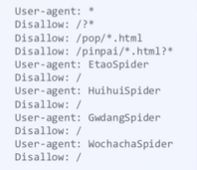Python网络爬虫与信息提取——requests库
这是北京理工大学的课程,附上视频link:https://www.bilibili.com/video/av9784617/?p=1
Requests库
Requests库主要方法
| Requests库的7个主要方法 | |
| 方法 | 说明 |
| requests.request() | 构造一个请求,支撑以下各方法的基础方法 |
| requests.get() | 获取HTML网页的主要方法,对应于HTTP的GET |
| requests.head() | 获取HTML网页头信息的方法,对应于HTTP的HEAD |
| requests.post() | 向HTML网页提交POST请求的方法,对应于HTTP的POST |
| requests.put() | 向HTML网页提交PUT请求的方法,对应于HTTP的PUT |
| requests.patch() | 向HTML网页提交局部修改请求,对应于HTTP的PATCH |
| requests.delete() | 向HTML页面提交删除请求,对应于HTTP的DELETE |
| Response对象的属性 |
|
| 属性 |
说明 |
| r.status_code |
HTTP请求的返回状态,200表示连接成功,404表示失败 |
| r.text |
HTTP响应内容的字符串形式,即url对应的页面内容 |
| r.encoding |
从HTTP header中猜测的响应内容编码方式,如果header中不存在charset,则认为编码为ISO-8859-1 |
| r.apparent_encoding |
从内容中分析出的响应内容编码方式(备选编码方式) |
| r.content |
HTTP响应内容的二进制形式 |
| 理解Requests库的异常 |
|
| 异常 | 说明 |
| requests.Connection Error | 网络连接错误异常,如DNS查询失败、拒绝连接等 |
| requests.HTTPError | HTTP错误异常 |
| requests.URLRequired | URL缺失异常 |
| requests.TooManyRedirects | 超过最大重定向次数, 产生重定向异常 |
| requests.ConeetTimeout | 连接远程服 务器超时异常 |
| requests.Timeout | 请求URL超时,产生超时异常 |
| r.raise_for_status() | 如果不是200,产生异常requests.HTTPError |
使用r.raise_for_status()检查异常,使代码更健壮
爬取网页的通用代码框架
#通用代码框架框架
def getHTMLText(url):
try:
r = requests.get(url, timeout=30)
r.raise_for_status()
r.encoding = r.apparent_encoding
return r.text
except:
return "error"
if __name__ == "__main__":
url = "http://www.baidu.com"
print getHTMLText(url)HTTP协议
HTTP, Hypertext Transfer Protocol,超文本传输协议。HTTP是一个基于“请求与响应”模式的、无状态的应用层协议。
URL格式htp://host[:port][path]
host:合法的Internet主机域名或P地址
port:端口号,缺省端口为80
path:请求资源的路径
HTTP URL的理解:
url是通过http协议存取资源的internet路径,一个url对应一个数据资源。
网络爬虫的限制
◆来源审查:判断User-Agent进行限制
检查来访HTTP协议头的User-Agent域, 只响应浏览器或友好爬虫的访问。
◆发布公告: Robots协议
告知所有爬虫网站的爬取策略,要求爬虫遵守。
Robots协议
Robots Exclusion Standard网络爬虫排除标准
作用:网站告知网络爬虫哪些页面可以抓取,哪些不行。
形式:在网站根目录下的robots.txt文件。
在爬取某一个网站时,可以“网站”+“robots.txt”查看是否限制爬虫
案例:京东的Robots协议
https://www.jd.com/robots.txt
*代表所有
user-agent:HuihuiSpider Disallow:/ -->表明针对user-agent是HuihuiSpider,整个网站都不可以爬取
实例1:京东商品页面的爬取
try:
r = requests.get("https://item.jd.com/100000177760.html")
r.raise_for_status()
r.encoding = r.apparent_encoding
print r.text[:1000]
except:
print "error"
实例2:亚马逊商品页面的爬取
try:
r = requests.get("https://www.amazon.cn/dp/B01NAS120J/ref=cngwdyfloorv2_recs_0/462-8269923-3092529?pf_rd_m=A1AJ19PSB66TGU&pf_rd_s=desktop-2&pf_rd_r=2RAT2AKB28AT2ZBSCDBE&pf_rd_r=2RAT2AKB28AT2ZBSCDBE&pf_rd_t=36701&pf_rd_p=d2aa3428-dc2b-4cfe-bca6-5e3a33f2342e&pf_rd_p=d2aa3428-dc2b-4cfe-bca6-5e3a33f2342e&pf_rd_i=desktop")
r.raise_for_status()
r.encoding = r.apparent_encoding
print r.text[:1000]
except:
print "error"
#对比传入headers和不传入headers的区别,在第二种可以发现user-agent改变了
r = requests.get("https://www.amazon.cn/gp/product/B01M8L5Z3Y")
print r.status_code
print r.request.headers
kv = {'user-agent':'Mozilla/5.0'}
r = requests.get("https://www.amazon.cn/gp/product/B01M8L5Z3Y", headers=kv)
print r.request.headers
实例3:百度360搜索关键字提交
#百度关键词接口
kv = {'wd':'python'}
r = requests.get("http://www.baidu.com/s", params=kv)
print r.request.url
print len(r.text)
#360关键词接口
kv = {'q':'python'}
r = requests.get("http://www.so.com/s", params=kv)
print r.request.url
print len(r.text)
实例4:网络图片的爬取和存储
url = "https://www.nationalgeographic.com/animals/2019/04/polar-bears-algae-sea-ice-warming/#/01-polar-bears-algae-nationalgeographic_675501.jpg"
root = './pics/'
path = root + url.split('/')[-1]
try:
if not os.path.exists(root):
os.mkdir(root)
if not os.path.exists(path):
r = requests.get(url)
with open(path, 'wb') as f:
f.write(r.content)
f.close()
print '文件保存成功'
else:
print '文件已存在'
except:
print '爬取失败'
实例5:ip地址归属地的自动查询
url = 'http://m.ip138.com/ip.asp?ip='
try:
r = requests.get(url + '202.204.80.112')
r.raise_for_status()
r.encoding = r.apparent_encoding
print r.text[-500:]
except:
print '爬取失败'
